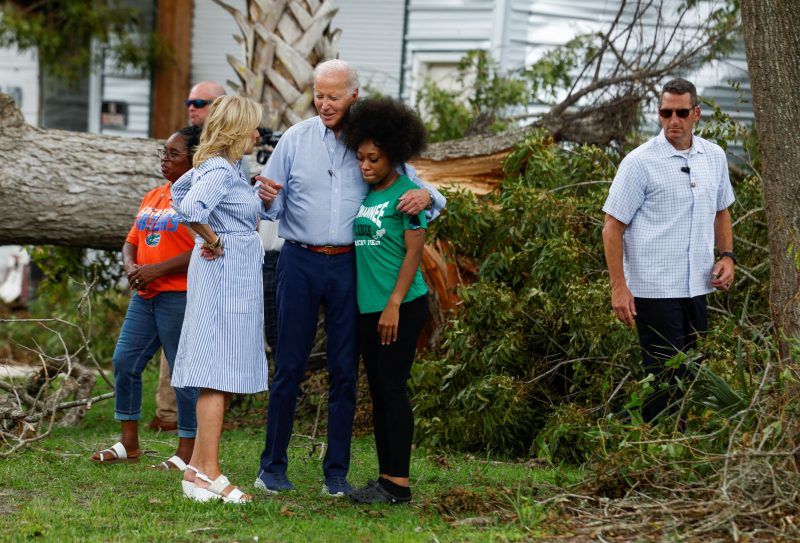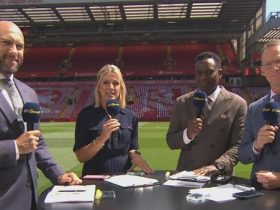LIVE OAK, Fla. — President Biden traveled to Florida on Saturday to survey the damage caused by Hurricane Idalia, part of a storm response he assured would not be mired in politics.
But the trip quickly became ensnared in the partisan squabbling of the 2024 presidential race as Florida Gov. Ron DeSantis, a Republican seeking to oust Biden from office, criticized the president’s visit and declined to meet with him.
During his visit, Biden dismissed the idea the governor’s absence was a sign that political considerations had impacted the recovery effort.
“I’m not disappointed. He may have had other reasons,” Biden said, adding that the Federal Emergency Management Administration had coordinated closely with the governor’s office before the visit. “But he did help us plan this.”
Biden had said Thursday that he would meet with DeSantis in Florida, but the next day the governor’s office suggested the visit would be disruptive to the response effort after the Category 3 hurricane battered a rural part of the state.
“In these rural communities, and so soon after impact, the security preparations alone that would go into setting up such a meeting would shut down ongoing recovery efforts,” Jeremy Redfern, the governor’s press secretary, said Friday.
White House officials disputed that characterization, with spokeswoman Emilie Simons saying that the visit had been “planned in close coordination with FEMA as well as state and local leaders to ensure there is no impact on response operations.”
The dueling comments underscored how disaster response has become another battle in the race for the presidency, and Florida is shaping up to be a key state for several reasons. DeSantis is trailing former president Donald Trump, a Florida resident, in the Republican primary. His supporters point to his handling of the hurricane as evidence that he would be a strong executive amid national crises. Biden’s campaign, which is targeting Florida’s 29 electoral votes despite Democrats’ struggles there in recent years, has also sought to showcase the president’s disaster management and proactive stance on climate change and extreme weather.
Disaster aid could quickly become mired in more partisanship back in Washington as Congress duels over government funding with FEMA in dire need of money. The White House recently increased its request for disaster aid money, bringing the total ask for the agency to $16 billion, but several right-wing House Republicans have called for steep spending cuts.
The mix of issues at play had made the potential meeting between the 44-year-old DeSantis and the 80-year-old Biden, who have met twice before amid tragedy, a critical moment in the political trajectories of both men.
Biden hardly mentioned DeSantis during his trip, instead trading compliments with Florida’s former governor, Republican Sen. Rick Scott, who praised FEMA and the broader federal response effort.
“I want to thank him for his cooperation and his help,” Biden said of Scott after touring a damaged neighborhood and meeting with survivors and first responders.
Asked about DeSantis’s decision to skip the visit, Scott said he didn’t know “what else he was doing.”
“I’m here because, one, the federal government is part of this,” said Scott, who at times has clashed publicly with DeSantis. “I want to make sure FEMA does their job. My experience with FEMA has been really good.”
DeSantis posted photos of himself on social media visiting other affected parts of the state on Saturday, including Horseshoe Beach, Fla., about 70 miles south of where Biden was touring, where the governor handed out chicken sandwiches.
Earlier in the week, the president had offered positive words about DeSantis, asserting that the two men’s political differences would not come into play in the disaster response.
“This is not about politics,” Biden said Wednesday, adding that his discussions with DeSantis had been based on a shared sense of trust. “This is about taking care of the people of his state.”
Biden, who traveled with first lady Jill Biden, visited the town of Live Oak, in a northern part of Florida that was hit hard. He toured the damage via helicopter and met with local leaders. He ended his visit with remarks designed to reaffirm a long-standing commitment to the impacted areas.
“We’re not going anywhere,” he said Saturday, standing in front of local officials and residents. “We’re here to help the state as long as it takes.”
Hurricane Idalia slammed into Florida’s Big Bend area on Wednesday as a Category 3 storm. Tied for the strongest hurricane on record to make landfall in the Big Bend, the storm produced a devastating storm surge and destructive winds in the region before sweeping across southeastern Georgia and South Carolina with flooding rains. DeSantis said during the week that there was only one death linked to the storm, a contrast to Hurricane Ian last year, which killed 149 per one revised state estimate.
A White House official, speaking on the condition of anonymity to disclose private discussions, said the president told DeSantis about his visit early on Thursday. The governor did not express any concerns at that time, the official said.
During a visit to Fort Myers Beach, Fla., in October, Biden met with DeSantis and praised his stewardship in the aftermath of Hurricane Ian.
“I think he’s done a good job,” Biden told reporters when asked about the governor’s handling of the deadly storm. “We have very different political philosophies, but we’ve worked hand in glove.”
DeSantis, who had not yet entered the presidential race but was a few weeks away from cruising to reelection in Florida, also thanked the president and praised the federal response to the storm.
Biden has often used natural disasters to showcase his presidency as competent and empathetic. He has also tried to showcase bipartisanship.
Trump, by contrast, at times became critical of the states that were seeking help after catastrophes — oftentimes in areas that did not support him in the 2016 presidential election. In 2019, for example, he threatened to cut off federal aid to California as it dealt with wildfires, accusing Gov. Gavin Newsom (D) of mismanagement.
Trump also held up an aid package for Puerto Rico for three years, calling its leaders corrupt before releasing the aid just before the 2020 election in what Democrats called an effort to win votes in Florida. In the aftermath of Idalia, Trump has blasted DeSantis’s management of Florida’s electricity and insurance industries.
Early in his presidency, Biden mobilized his administration to respond to weather-related incidents across the South. He held a number of calls with governors in seven states, many of them Republicans in areas that voted overwhelmingly against him. He also visited Florida and met with DeSantis after the 2021 Surfside condo collapse.
Some governors have credited Biden with swiftly approving states of emergency, delivering federal resources and funding. Biden approved Florida’s requests for disaster declarations after Idalia and pledged continued support.
But at the same time, Biden has not shied away from linking extreme weather events to climate change, an approach that is at odds with the stances of many of the Republican officials he meets with. He did the same during his visit to Live Oak on Saturday, while standing in front of a house where a large tree had been felled by the hurricane.
“Nobody can deny the impact of the climate crisis,” he said, citing the series of storms, floods, wildfires and heat waves that have occurred since he took office. “It’s been devastating.”
While visiting Florida after Hurricane Ian, Biden stood next to DeSantis and spoke about how the storm was further evidence that climate change was wreaking havoc around the country.
“What the governor’s done is pretty remarkable,” Biden said of DeSantis at the time. “The governor has recognized that there’s a thing called global warming.”
Previous interactions between governors and presidents from opposing parties have sometimes been used in partisan attacks against the politicians involved.
Former Florida governor Charlie Crist, who ran as a Democrat against DeSantis in last year’s gubernatorial race, was driven from the Republican Party not long after he welcomed President Barack Obama to the state and accepted emergency aid from the federal stimulus package in 2009. Crist later said that the image of him and Obama embracing was used by his political opponents to paint him as insufficiently conservative. He has since lost three statewide races, including last year’s nearly 19-point defeat to DeSantis.
Former New Jersey governor Chris Christie, who is running for the GOP presidential nomination, still faces attacks from Republican rivals for welcoming Obama to New Jersey after Hurricane Sandy devastated his state in 2012. Images of Christie and Obama embracing circulated, and his Republican opponents accused him of boosting the Democratic president ahead of the 2012 election.
Christie later said he met with Obama because he needed federal help for his state after the deadly storm, but the criticism has been sustained. Entrepreneur Vivek Ramaswamy brought up the decade-old meeting during last month’s GOP presidential debate, saying Christie’s support helped elect Obama to a second term.
During the debate, DeSantis blasted Biden’s response to the Maui fires that killed more than 100 people last month. Biden, who was on vacation as the toll of the crisis became clear, waited more than 10 days to visit Maui. White House officials said he coordinated with the state’s governor to ensure the trip would not impact the recovery.
“As somebody that’s handled disasters in Florida, you’ve got to be activated,” DeSantis said, suggesting that the president was not appropriately engaged. “You’ve got to be there. You’ve got to be present. You’ve got to be helping people who are doing this.”
Matt Viser in Washington contributed to this report.








